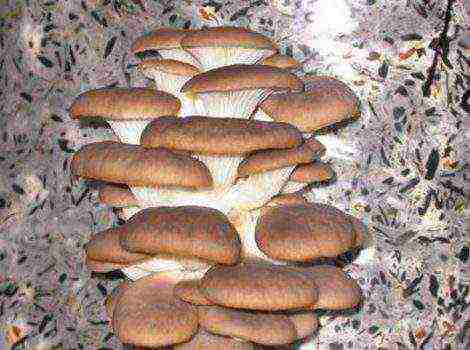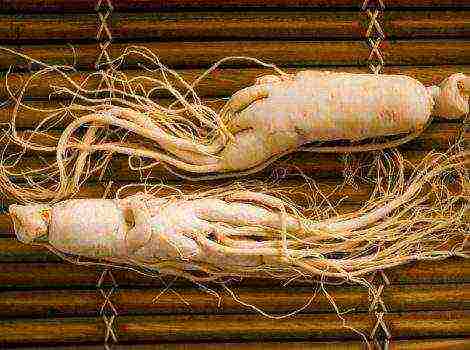Content [show]
You can save great money by growing these foods at home.
Growing plants from seeds is correct and logical, but truly unusual is to grow vegetables and fruits from their leftovers. Does it take more time? Yes. Does it make going to the store easier? Definitely! Then let's get started ?!

Level 1: novice gardener
1. You can grow green onions from bulbs.
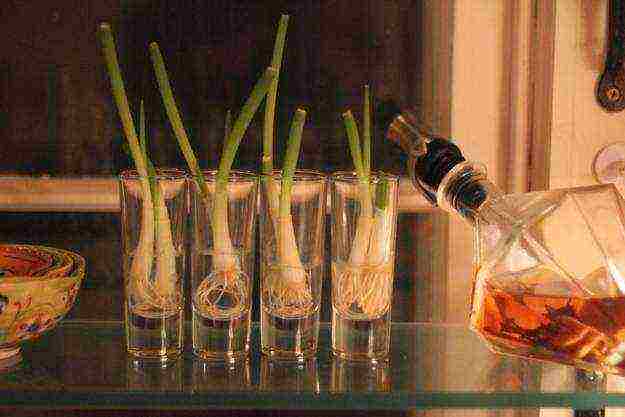
Green onions are the simplest things you can grow at home. Change the water every day and you will see the result in a week.
2. You can grow garlic sprouts (they are edible) from a garlic clove.
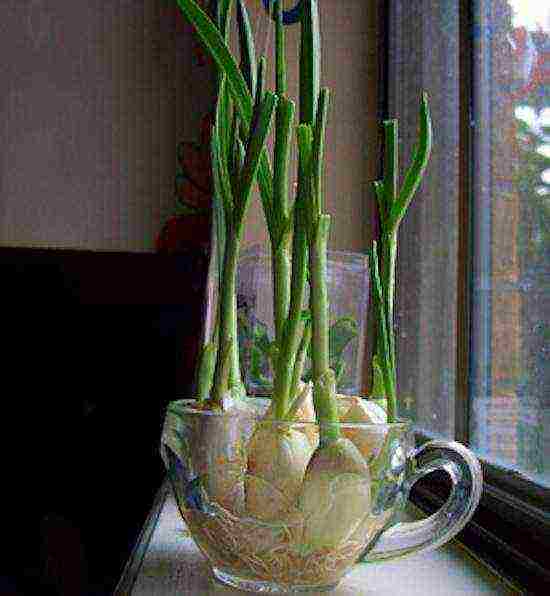
Or, you can only use the garlic itself after it has grown.
3. You can grow a variety of romaine lettuce from the bottom.
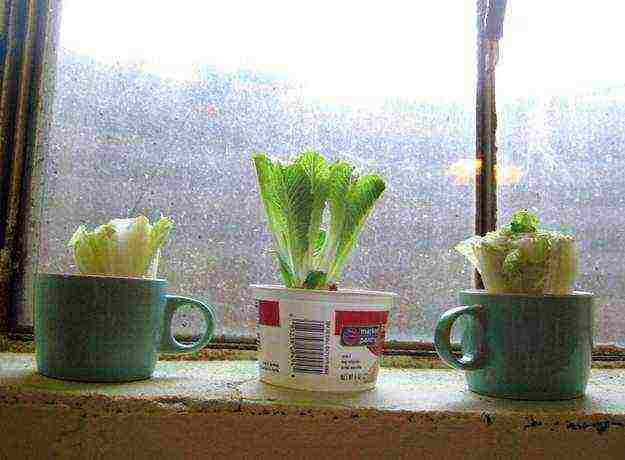
You don't need soil to grow lettuce, but if you do grow in soil, the leaves will be twice as large. The same principle can be used to grow cabbage.
4. Try to sprout carrot tops using only the top of the carrot.
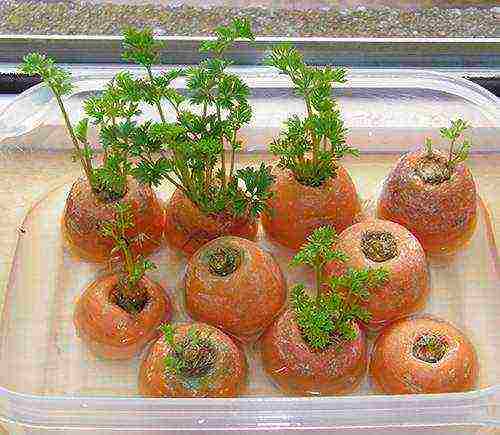
At first glance, this looks more like a school experiment than what you are about to eat. Carrot tops may be slightly bitter, but you can crush some garlic into them, add vinegar and honey to sweeten them.
5. Basil can be grown from cuttings.
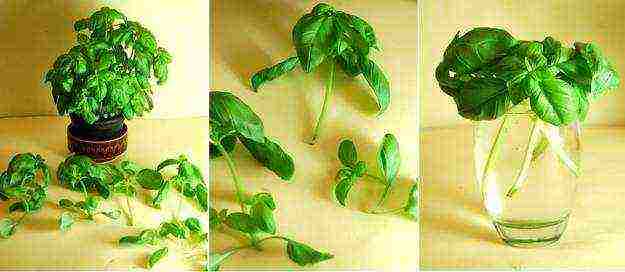
Basil's supplies can be literally endless. Change the water as often as possible to keep the plant from getting mucus.
Level 2: confident amateur
6. Lemongrass also grows from the bottom of its stem ...
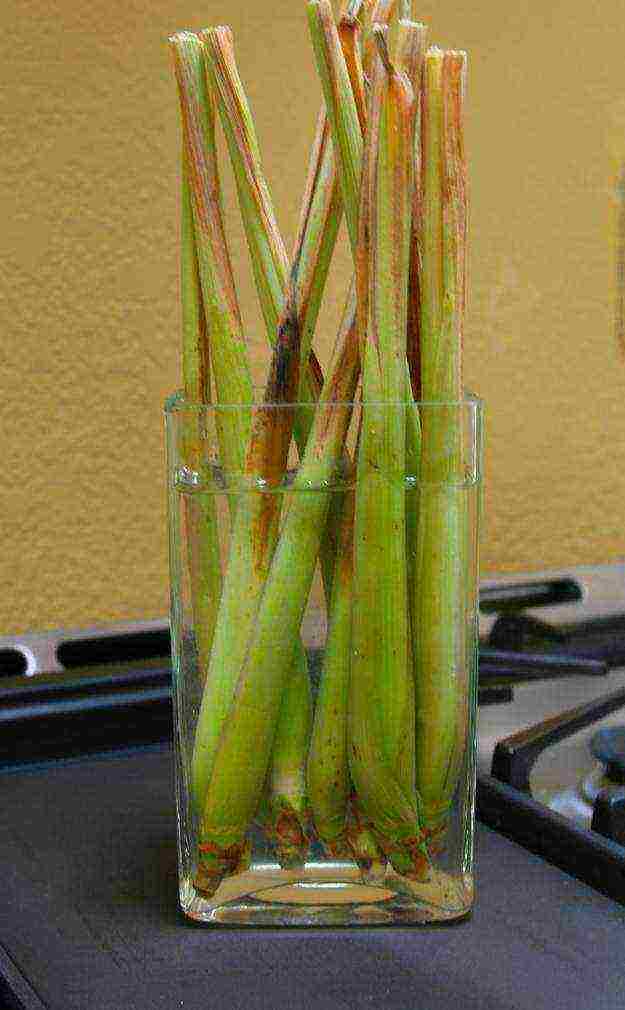
The underside of the lemongrass stem is too hard to cook, so it can be used to grow new stocks without having to discard half of the plant. Let the lemongrass pieces sit in the water for about three weeks. When you see that the roots have appeared, then transplant them into the soil and place them on a sunny windowsill.
7.… like celery.
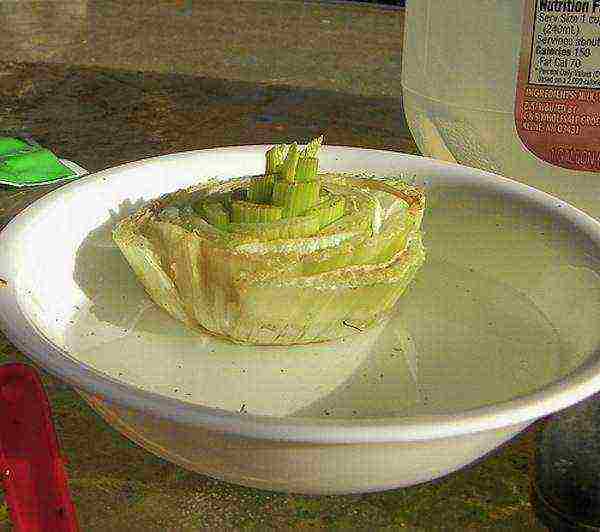
Looks strange, right? Leave some of the celery in the water for three days, then be sure to transplant it into soil.
8. But the onion sprouts from the bottom of the onion.
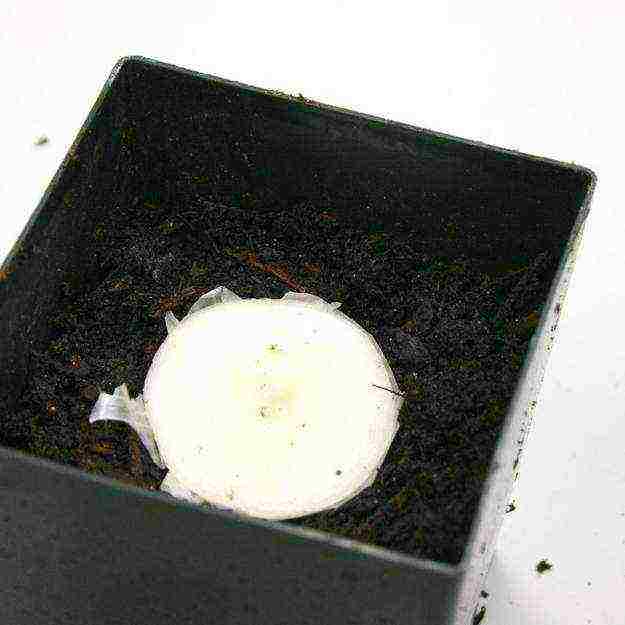
It seems odd that you can simply cut off a piece of an onion, plant it in the soil, and after a while something magical will happen.
9. Chinese cabbage can be grown from its leftovers.

It is grown according to the same principle as celery.
Level 3: Experienced Gardener
10. A small tree grows from the avocado seed.
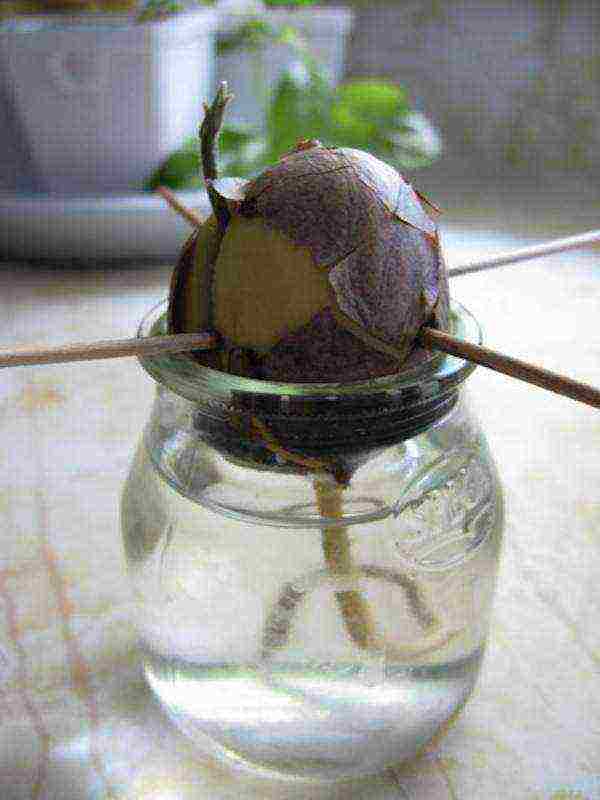
The seed can only germinate from a ripe fruit, but the seed must be removed from the fruit before planting. Growing an avocado requires a lot of attention. In order for the first avocados to sprout, the plant will take 5 to 13 years. If you are confident and have a lot of free time, then why not?
For this:
- Wash the seed. Using three toothpicks, insert them into the part of the seed that is not in the water.
- Place it in a warm place with direct sunlight and change the water as needed.You will see the roots and stem grow back in about two to six weeks.
- When the base is 15-17 cm long, cut it back to about 7-8 cm.
- When the roots are thicker and the base is green foliage, transplant it into a pot of humus-rich soil, planting only half the seed.
- Water the plant frequently. Usually the soil should be moist, but not damp. Yellowish leaves are a sign that there is too much water. If this happens, stop watering the plant for a few days.
- The more sunlight the better.
- If the leaves turn brown and dry out at the tips, this indicates that too much salt has accumulated in the soil. In this case, pour a little water on it and let it soak into the soil for a few minutes.
- When the stem is 30cm tall, cut it back to 15cm to allow new shoots to grow.
- Don't expect your houseplant to bear fruit. Although this does happen sometimes, it usually requires transplants. A plant grown from seed will take 5 to 13 years to flower and fruit. Fruits on trees grown from seeds are rarely suitable for consumption.
11. Sweet potatoes sprout from which new fruits will emerge.
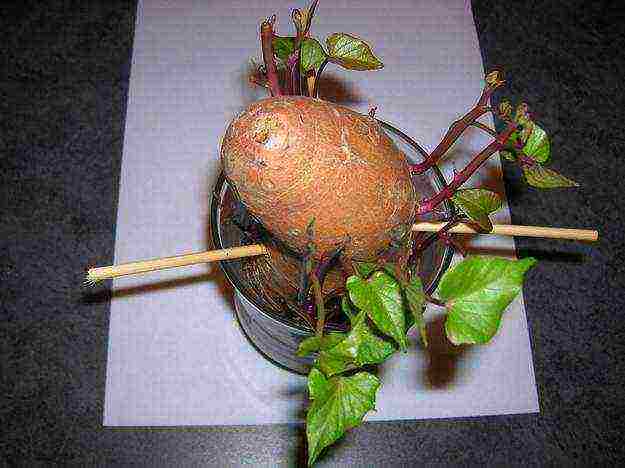
Sweet potatoes grow from shoots, not seeds or potato pieces like white potatoes. Sweet potatoes can be grown in both water and soil (only half of the tuber should remain in the soil).
To grow in water, place the tuber in a bowl of water, but stick wooden sticks (you can use toothpicks) on both sides and then it will start growing faster. You can put the cup both on the window and on the refrigerator - there will be no difference in plant growth. When grown in water, you can get about 50 shoots from one tuber.
Over time, he will need much more space.
Potatoes also grow fairly quickly in soil. It is much more convenient to grow potatoes in the garden. If the grown potato leaves lie in the soil for a long time, then later they can also bear fruit. These leaves can be eaten because they are edible and you can find recipes for making them. But when growing outside the home, keep in mind that potatoes are very sensitive to cold.
12. You can grow ginger from its roots.
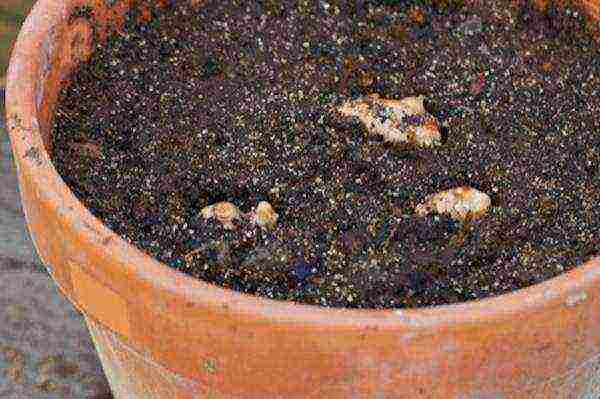
Shoots can germinate only after a few months and only after a year expect a harvest, but at least this undertaking will not require special expenses.
Prepare some rhizomes that are already budding. You will notice greenish outgrowths at the tops of the rhizomes. The roots must be large and healthy. Cut them into pieces so that each has a scion. If they dry out, they most likely will not germinate. Soak ginger in water overnight.
Fill the pot with soil and plant the rhizomes with the sprouts facing down. Press the rhizomes lightly into the soil and pour in some water. If you live in a cold climate, then put the pot on the sunny side, and sat in a hot, then on the shady side. Ginger is a tropical plant and loves heat, but it cannot tolerate too much sun in this climate.
Water the plant periodically and be patient. It may take quite a long time (from 3 months) before the first shoots appear.
13. Try growing a pineapple from the top.
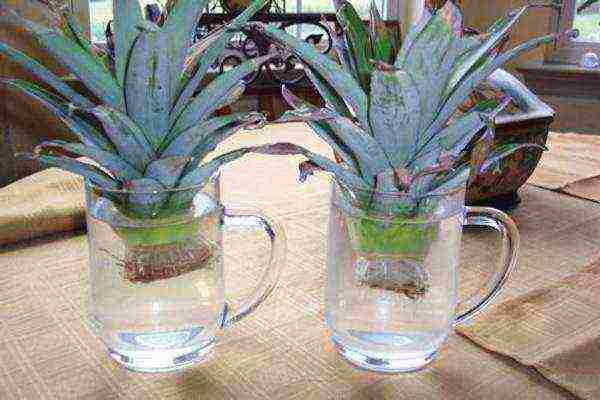 height = "400 ″ alt =" can I grow at home "/>
height = "400 ″ alt =" can I grow at home "/>
That's right, you can grow pineapple right at home, but it will take about 3 years.
Step 1. Get mature pineapple from any grocery store that has healthy, green leaves (not yellow or brown) and a golden brown skin. Your best bet is to try growing two pineapples in case one of them doesn't sprout. If you decide that you bought too many pineapples than you can eat, then simply cut them up and freeze them. Frozen pineapple tastes great!
Step 2. Prepare the top.Take the entire top with all the leaves and twisting movements try to pull it out with a small part of the stem (If you just cut off the top, then you will have to remove all excess fruit pulp, otherwise the rotting processes can kill the entire fruit). After removing the stem, carefully slice small, horizontal sections from the bottom of the apex until you see root buds that look like small dots or circles on the cut surface. Cut as little as possible to avoid cutting off the base, which will then germinate. Once the tip is ready, let it dry for a couple of days before proceeding to the next step.
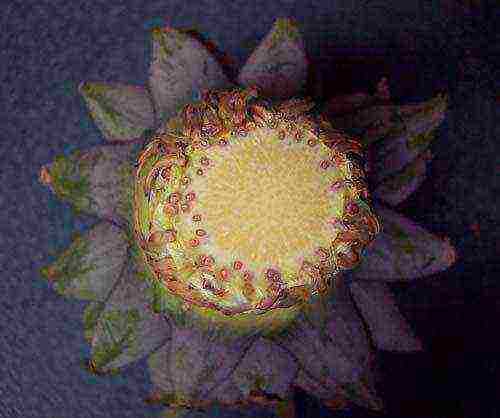
Step 3. Let the roots germinate from the top. Place the top in a clear glass vase of water and change the water every few days. Set the vase out of the way in a place that is neutral (not too hot or too cold), such as at the top of the refrigerator. After three weeks, you should be able to see the root sprouting.

Step 4. Once the roots appear, transplant the pineapple into a clay pot with potting soil, with perlite at the bottom. A clay pot 45 cm in diameter with a drainage system is ideal for this. The perlite layer should be approximately 5 cm at the bottom of the pot before adding the mixture.
The soil should always be slightly damp (not wet, which will cause rotting, and not dry). It will take 6 to 8 weeks for the stem to emerge for strong roots to sprout. Don't speed up this process.
Over time, you will begin to notice that the leaves that were originally on the pineapple will begin to die off and turn brown, but new ones will grow to replace them. Cut off dead leaves throughout the year, and water the pineapple no more than once a week. If they grow up, then everything is going as it should. As soon as the year has passed, the plant will need to be transplanted.
Step 5. Transplant.
When replanting, avoid getting soil between the leaves. As the pineapple and its roots grow, it will also need to be transplanted into an even larger pot.
In winter, the pineapple stops growing, but growth should resume with the onset of spring. If it doesn't, then gently pull it out of the soil and check the roots. Change the potting mix if necessary.
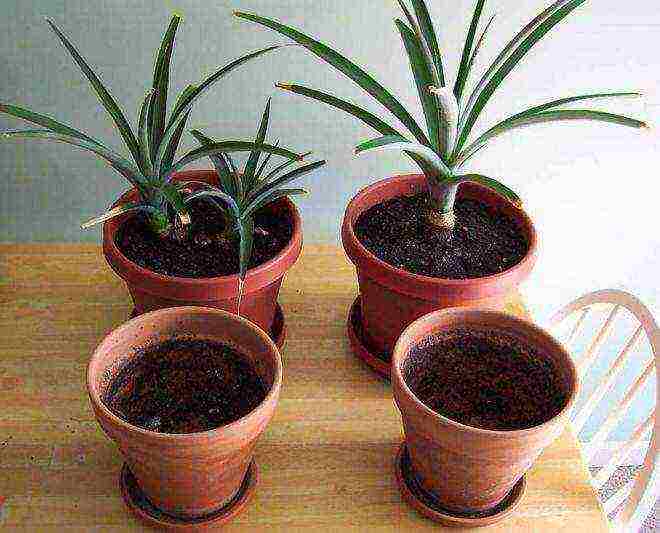
Pineapple is a tropical plant and cold temperatures can kill it easily.
Pineapples need at least 6 hours of bright light every day. In the summertime, place the plant on the sunny side of a windowsill or even in a garden.
Growing many vegetables and fruits on your own is not at all difficult, but even very exciting. You don't even need seeds.
Green onions, leeks, shallots and fennel

To grow these indispensable plants at home, you can use either the bottoms with roots (the lower white part, which we usually cut and discard), or whole bulbs. To do this, you need to place them in a glass jar with a small amount of water and put them on the windowsill, where the onion will receive the sunlight it needs. After a while, the first feathers will appear, which, as they grow, can be cut off and added to food. Thus, you will always have fresh herbs at hand - most importantly, do not forget to add water to the jar once a week.
Cymbopogon

The aromatic citrus seasoning Cymbopogon or Lemongrass is essentially a perennial herb and should be grown like any other herb. After using the stem, do not discard the root - place it in a jar of water and place it in the light. After a week, the cymbopogon will sprout and will need to be transplanted into the ground. When the stem of the sorghum grows to about 30 cm in length, it can be cut and dried.
Celery, bok choy, romaine lettuce and cabbage

These vegetables can be grown at home from the remnants of their hard, thickened stems. To do this, pour water into a shallow cup and place the stump in it with the roots down.Celery, bok choy, romaine lettuce and cabbage are very moisture-loving, so be sure to add water to them. After a few days, you will notice that roots and new leaves will appear, and after another week, the plants can be planted in the ground.
Ginger
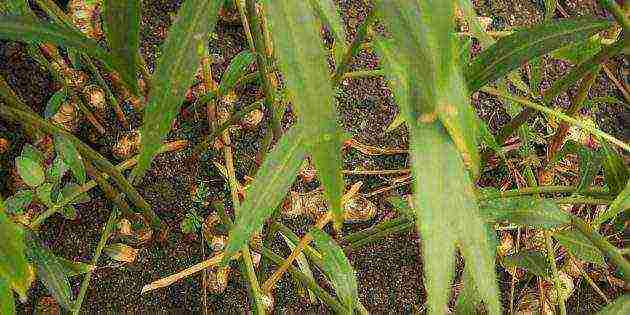
To grow ginger at home, you need a piece of fresh and smooth ginger root with a couple of live buds. If the root is too dry, you can soak it in warm water for a while. It is necessary to plant ginger in a pot or box with the soil, buds up. The ideal conditions for this plant are a warm, humid, bright place, but without direct sunlight. In addition to the fact that ginger is tasty and healthy, it is also beautiful (somewhat reminiscent of reeds), so it can be grown even for decorative purposes.
Potato
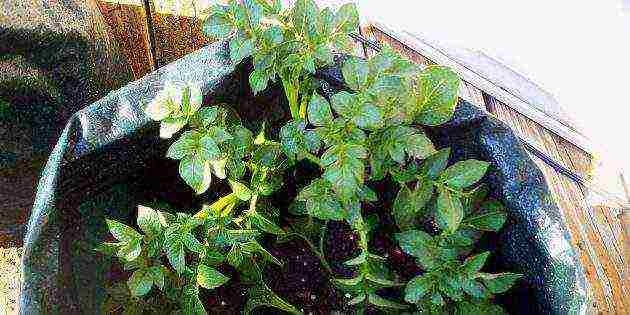
Many townspeople are simply distracted by the phrase "plant potatoes" - it's easier to buy than to "hunchback" in the country all summer. And in vain, because this vegetable can be grown right at home. To do this, you need one small potato with "eyes". It must be cut into several pieces and left at room temperature for a couple of days so that it dries up and does not rot in the ground after planting. It is recommended to plant potatoes in well-fertilized soil. In this case, it must be buried to a depth of at least 20 cm, so make sure that the dishes for planting are large and deep enough.
Garlic
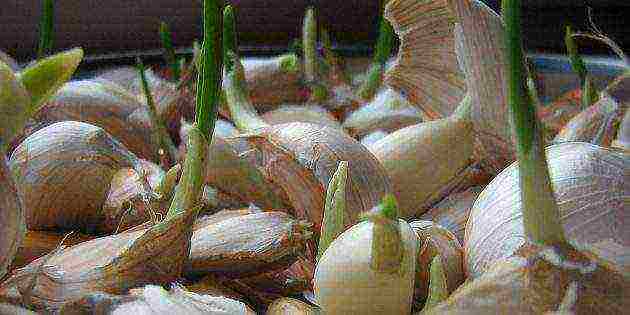
Growing garlic is very simple: take one or two cloves with roots and stick them into the ground in a warm, bright place. When the root system is strengthened, the garlic will give its first shoots. They need to be pruned in a timely manner so that they do not take "energy" and do not interfere with the formation of the bulb.
Onion
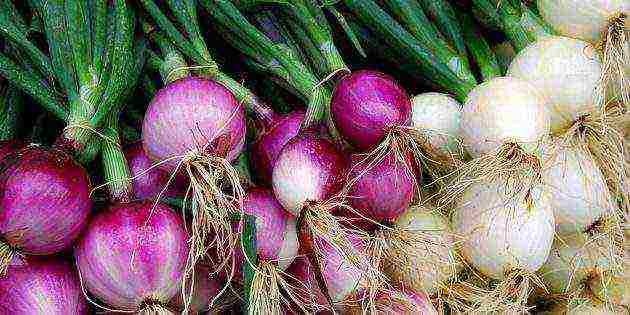
Oddly enough, at home it is quite easy to get a crop of "tear" vegetable: take an onion, cut off the bottom with roots and plant it in moist soil. Onions love the sun, so choose a warmer spot for it.
Sweet potato
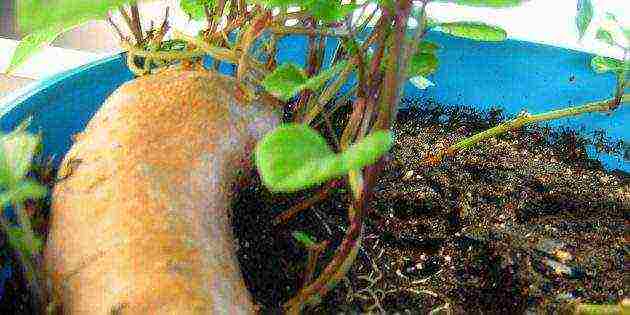
The rules for planting and growing sweet potatoes are almost the same as those of regular sweet potatoes. We take a tuber and send it to moist soil. A week later, the sweet potato will sprout, and when the leaves reach 10 cm, they can be cut, and another plant can be planted at a distance of 25–30 cm. Just make sure that slugs do not start on the lashes - they are very fond of sweet potatoes. And then after 4 months you will have juicy sweet potatoes.
Mushrooms
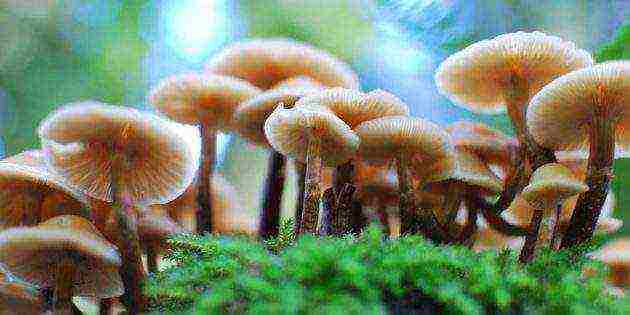
Mushrooms are difficult to grow at home, as they need special conditions - high humidity, special temperatures, ventilation and lighting. For their planting, the so-called mycelium is needed, that is, germinated spores of mushrooms. The mycelium is placed in a substrate (a mixture of oats, millet, rye, barley and other cereals), where it takes the form of thin white threads, from which mushrooms then grow. Attention: for successful growth, mushrooms need a humidity of 95% and a temperature of no more than 20 ºС. In addition, during ripening, mushrooms release a strong allergen into the air, so experts do not recommend growing mushrooms in an apartment. The ideal option is a plot near the house or, in extreme cases, a balcony.
A pineapple

But turning your home into a tropical "island", on the contrary, is quite simple. It is enough to cut off the top with leaves (do not forget to clean the pulp, otherwise the plant will rot) and place it in a glass of water. Soon, roots will appear on the outlet, which means the pineapple is ready for planting. Remove some of the lower leaves and stick the rosette about 2–3 centimeters into the ground. This fruit is quite unpretentious, it easily tolerates direct sunlight and high temperatures. The main thing is not to forget about regular watering. After 1-2 months, young sprouts will appear on the pineapple - this means that the stalk has taken root, and after a couple of years you can harvest the first crop.
Your success in home gardening depends on many factors - weather, soil, the quality of the "seedlings" and, of course, on how carefully and carefully you will treat your green "pets".You may very quickly get bored with all these pots on the windowsill, but it's still worth a try - let your children see with their own eyes how onions, cabbage and potatoes grow.
Read also
- 20 Unkillable House Plants That Will Survive Almost Without Maintenance →
- 5 indoor plants that produce the most oxygen →
- Indoor plants that cannot be kept in a house with small children →
- Plants that can kill your pets →


Sometimes I want to go out onto the balcony, like Jamie Oliver, pick up my own grown vegetables and herbs and stir something stunning out of them. And the balcony, by the way, looks much nicer if it does not store old pieces of iron that it is time to send to the landfill, but aromatic herbs and vegetables.
chose several interesting plants that take root well on the windowsill or on the balcony.
Pepper
On the windowsill, you can grow a hot pepper for diablo pizza. It will require a warm, bright place and varieties suitable for home cultivation: "Carmen", "Flint", "Ogonyok", "Ryabinushka", "Bride", "Indian Summer", etc.
The bushes are very cute and do not require large pots. Up to 50 fruits can be set on one plant. The optimum temperature is 25-27 degrees Celsius.
Carrot
For growing carrots at home, it is better to take mini-varieties such as "Parmex", "Sophie", "Vnuchka". They grow in 80-90 days and do not require much space - a pot or container is fine. You can also take a funny round variety "Round baby".
The soil for the carrots should be light and well-drained. The vegetable can be grown in cut plastic bottles. The optimum temperature is in the range of 13-24 degrees Celsius.
Mint
Mint is a non-capricious and undemanding plant. It can grow on your windowsill or balcony even in winter, if you arrange additional lighting. It can be grown from cuttings and seeds. If there is an opportunity to dig up a stalk in the country at home or from friends, it is better to use this method. Mint, grown from seeds, is not taken as actively, and it will take longer to wait for the harvest.
It is important to remember that the plant loves well-moisturized soil. And when choosing a place for it, keep in mind that the lighting should be good, but it is better to avoid direct sunlight. The optimum temperature for mint is 20-25 degrees with a plus sign.
Green onions
Growing green onions at home does not require any special dexterity. But nevertheless, it is worth considering some nuances: the bulb that you will plant should be round, firm to the touch and without any signs of rot, the root cup should be well-formed.
Immediately after planting, it is worth putting the onion in a cool, dark place so that the root system is better formed, and only then the feather will need a lot of light. The optimum temperature is 18-20 degrees, you should not overheat, because then the growth of greenery will stop.
Basil
Any kind of basil grows well in flower pots and boxes. It is better for him to allocate a sunny place, water well, keep warm and provide good drainage. For planting, you can use both cuttings and seeds. At the same time, the cuttings will quickly give the first harvest, but they will not last long, since they will bloom quickly. You will have to wait longer to harvest from seeds, but such a bush will also last longer.
The optimum temperature for basil is 20-25 degrees Celsius. In winter, backlighting is required for about 3-4 hours to increase daylight hours.
Cucumbers
To grow cucumbers on a windowsill or on a balcony, you should take a closer look at the hybrid varieties that are marked with the F1 icon. If all conditions are created for a plant, it can give 3-4 dozen fruits. Here you will have to tinker a little with the seedlings, but after transplanting into boxes, you will only need to water and cut the antennae.
Plants are planted in containers with a volume of at least 5 liters. It is important to remember that cucumbers are large water loaves and the ground should always be moist. The optimum temperature is 21-24 degrees Celsius.
Tomatoes
Dwarf varieties are usually chosen as home-grown tomatoes: Minibel, Florida Petit, Balcony Miracle, etc. You will have to take the most illuminated place in the apartment for this miracle. You will need to start with seedlings, then plant them in containers, tie them up, feed them and protect them from the cold. This is one of the most troublesome balcony crops, but pride in the work done and gardening talent is attached to the crop.
It is important to remember that tomatoes, like all plants, love water, but they can be easily poured over. Therefore, water should be done carefully. The optimum temperature is 23-25 degrees Celsius.
Sorrel
Sorrel, in addition to its wonderful taste, is distinguished by the fact that it calmly tolerates shaded places. It can be grown from rhizomes of 2-4-year-old plants with buds or from seeds of such varieties as "Maikop", "Altai", "Odessa broadleaf".
It can grow at 5 and 20 degrees Celsius and even withstands small frosts. So on the balcony it can be kept until the last, and if the balcony keeps heat well, then it should not be cleaned for the winter. The leaves are cut at a height of 8-10 cm, this must be done carefully so as not to damage the growth buds.
Ginger
Ginger is not only a delicious seasoning, but also a beautiful plant. If you plant it at home, the shoots can grow up to a meter in height. Pieces of ginger root are planted, consisting of at least a couple of sections with live buds. If the root is dry, you can hold it in warm water for several hours to wake up the kidneys.
The root should not be planted very deeply, and until the first shoots appear, it should be watered very sparingly. Keep ginger in the light, but away from direct sunlight. The optimum temperature is 20-25 degrees Celsius.
A pineapple
To grow pineapple at home, you need to be patient and find a suitable fruit - purchased in the warm season and with an intact tail. The tail is cut with a knife, preferably without pulp, dried for 3-4 days in the light, and then germinated in clean river sand. When the roots appear, after about a month, it can be transplanted into a pot of soil.
Pineapple loves light, warmth and spraying. The fruit will appear about 2 years after planting. The optimum temperature is 23-30 degrees Celsius.
Strawberry
Strawberries can be grown at home all year round, in winter you will need to arrange lighting. To do this, you should choose remontant strawberry varieties that bear fruit more than once a season, but constantly, for example: "Yellow Miracle", "Queen Elizabeth", "Mount Everest". You can grow strawberries from seeds, but the easiest way is to buy ready-made seedlings. After 3-4 months, a couple of bushes will give new rosettes, and your plantation will increase by 3 times. Meanwhile, as with the germination of seeds, you will have to tinker.
Strawberries are afraid of the cold, so they should be taken out to the balcony only when the weather is warm. The optimum temperature is 18-24 degrees Celsius. It is important to remember that since there are no insects at home, you will have to pollinate the flowers yourself with a brush.
Thyme
Thyme is a wonderful herb. It is very fragrant, tasty and extremely unpretentious. Thyme naturally grows in dry areas with poor soil. Therefore, ruining it at home is not easy. The most important thing he loves is light. It is not afraid of direct sunlight, and it can be placed even where other plants will die. The only difficulty is watering: in the sun, the soil in a small volume of the pot dries quickly, and the thyme itself does not like waterlogging.
It also makes no sense to overdo it with fertilizers - thyme will not appreciate it. It can be grown both from cuttings and seeds.
What goodies grow in your home?
In winter, you really want fresh herbs, fragrant berries, fruits and vegetables. I want to, but my hand unconsciously puts back the just taken package with Turkish tomatoes and cucumbers ... Just know how many real-life there is ...
And imagine: cucumbers, tomatoes, peppers, and greens in the midst of winter you can grow yourself without leaving your home - on your two or three windowsills! And along the way, create a summer cottage landscape right in your apartment. No, no, no kidding, if you decide today, and tomorrow you go to the store for seeds, then on March 8, the first cucumbers may already appear on your bushes, and the grown bushes of tomatoes, peppers and beans will make your windowsill green and joyful in summer !
And let us convince you that it is interesting, exciting, important, necessary and not difficult at all! We can grow at home cucumbers, tomatoes, sweet and bitter peppers, carrots, beans, garlic, celery, herbs ... oh-oh-oh, how many things!
Well, let's get it in order?
Cucumbers
Growing cucumbers at home is a very tempting idea. Just imagine: you wake up in mid-March, go to the window, pick a couple of young cucumbers from a green bush, and five minutes later there is a healthy vegetable salad on the table ... And what a smell all over the apartment!
If a thought flashed through you now: "Maybe I should try?" - here are some arguments to help you decide:
- Cucumbers grow very quickly: literally 7-9 weeks after planting, you can cut a salad from your greens!
- It is quite possible to grow cucumbers at home not only for a summer resident who has already "eaten a dog" in vegetable growing, but even for an inexperienced city dweller.
- And a control shot: just imagine how delighted your friends, colleagues and neighbors will be with young cucumbers on your windowsill! You will become an object of ah and ah for a long time))
Want to see how it might look? And here's how in this video:
Stop, stop, do not urgently run after the seeds that you have prepared for summer cottages! Everything is in order. First, we carefully read what you need to know and take into account when growing cucumbers at home.
Suitable varieties
Not all cucumber varieties are suitable for indoor cultivation. You need to choose
self-pollinated
hybrids ... It's best if they will
early maturing ... Even better - if they are also
bush ... And then -
shade-tolerant ))
Excellent proven themselves hybrids:
- ‘Marinda F1’
- ‘Onega F1’
- 'Masha F1'
- ‘Connie F1’
- ‘Legend F1’
- 'Claudia F1'
- ‘Tatiana F1’
- ‘Seryozha F1’
Good reviews are also about varieties:
- ‘Gribovchanka’
- 'Debut'
- ‘Zozulya’
- ‘Ragtime’
- 'Babylon'
- 'April'
- 'Flight'
- ‘Boyfriend’
- 'Athlete'
- ‘Kinglet’
- ‘NIIOH-412’
- ‘Cucaracha’
If you are just starting to grow cucumbers at home, choose from these varieties, you will not go wrong.
The necessary conditions
Cucumbers, like any other plant, have their own preferences. They are:
- photophilous, therefore, the eastern or southern side of the apartment (house) is best suited for growing them. If there is not enough light (and most often this is exactly the case), it will be necessary to organize additional lighting with fluorescent lamps.
- thermophilic, they need a temperature above + 20 ° C (at least + 22 ... + 24 ° C during the day).
- hygrophilous, therefore, the soil should always be moist (moderately, not overfilled).
Tomatoes
A red tomato is clearly not a winter or spring vegetable. Therefore, fresh tomatoes from your garden in April and May are an indescribable pleasure (and pride, whatever you say!).
Many do not dare to grow tomatoes in an apartment, fearing that they simply will not succeed. You know, the bushes strewn with red fruits on the windowsill are just at first glance, "how difficult it is to be horrified." Anyone can grow tomatoes at home. Almost everyone grows flowers in their apartments, and this process is no less complicated 🙂
If you are eager to try your hand at growing homemade tomatoes, heed the advice of our experienced summer residents.
Suitable varieties
Suitable for a home garden self-pollinated hybrids... Do not mess with tall varieties - you will suffer. Better to chooseundersized (or even dwarf ones).It is also worth sacrificing love for large tomatoes, it is better to plant small-fruited varieties - they ripen faster and easier.
There are a lot of tomato seeds on sale today of those varieties and hybrids that are specially designed for home cultivation:
- ‘Balcony miracle’
- ‘Room surprise’
- ‘Balcony Red F1’
- 'Alaska'
- ‘Betta’
- ‘Pearl red’
- ‘Pearl yellow’
- ‘Bonsai’
- ‘Japanese room’
- ‘News of Canada’
They enjoy special love
dwarf:
- ‘Minibel’
- 'Bonsai micro F1'
- ‘Pinocchio’
- ‘Florida petite’
- ‘Cherry Pigmy’
- ‘Lisa F1’
- 'Greenfinch F1'
Ampel varieties that look great in hanging pots are wonderful - such as:
- ‘Cherry’
- ‘Talisma’
- ‘Yellow pear’
- ‘Peruvian home’
- ‘Ildi’
Advice
: the store will offer you a lot of varieties of tomatoes, assuring that they are great for home growing. Listening to this and believing the seller, you still carefully read what is written on the packaging: the bags we need have special marks “Home garden”, “Harvest series on the window” or “Recommended for pot growing”. Now, if you saw such an inscription - feel free to pay money)
The necessary conditions
Caring for "home" tomatoes is not much different from caring for them in the country or in a personal plot.
- Tomatoes - plants light-loving, therefore, it is advisable for them to choose the south, southeast or east side. In winter, in an apartment, they need illumination (you can read more about lighting in the article 10 secrets of a home garden).
- They do not like stagnant air, they are afraid damp rooms.
- And here are not afraid of drafts, so feel free to ventilate the room where the tomatoes "live".
- Optimal daytime temperature for growing: before flowering and fruiting - + 22 ... + 25 ° C (night - about + 17 ° C), and then - preferably 2-3 ° C higher.
- Watering, as in the open field, requires rare but abundant.
Advice:
if you want the tomato bush to be symmetrically developed and beautiful, turn it 180 ° daily in relation to the light from the window - then it will build up the green mass evenly from all sides (some owners rotate the pots with bushes 90 °, considering what will be even more evenly))
Sweet pepper (bulgarian)
This southern juicy vegetable is quite suitable for "domestication", it is unpretentious, beautiful and very useful. Although you will have to be patient - you will be able to taste the first sweet peppers only 5-6 months after germination.
Growing it at home is interesting, to say the least. Yes, and profitable as well. How is it profitable? Yes, because pepper is a perennial plant, and the bushes planted today will delight you with their harvest for 2-3 years. Tempting? And then! If you decide to add bell peppers to your windowsill, get acquainted with the secrets of growing it.
Suitable varieties
As in the case of cucumbers and tomatoes, for a home garden you need to select early maturing self-pollinated hybrids... In home culture, varieties have proven themselves best. universal purpose, used both for planting in open ground and in protected:
- indoor pepper 'Patio-Ivo', which pleases with its bright yellow fruits at any time of the year on the windowsill or balcony;
- thick-walled peppers of the improved selection ‘California Miracle’ - up to 75 cm high, with beautiful bright red fruits with a ribbed surface;
- medium-early high-yielding hybrid of Dutch selection 'Jupiter F1' with very large fleshy fruits that change color from green to red;
- very sweet pepper of the 'Oda' variety - purple in color, undersized (35-50 cm) and very productive.
Good reviews received medium early varieties:
- 'Martin'
- ‘Bulgarian-79’
- ‘Gift of Moldova’
- ‘Novogoshary’
- 'Winnie the Pooh'
The necessary conditions
Bell pepper will not be "capricious" and will thank you with a good harvest, if you observe several important conditions for it:
- This plant is southern, so it must be placed in the sunniest room, where there is most of the light. If there is not enough light, it will be necessary to artificially illuminate it.
- Sweet pepper is a sissy, he does not like drafts.
- The optimum air temperature for its maintenance is + 20 ... + 26 ° C (at night + 18 ... + 20 ° C).
- Regular soil loosening necessarily.
- Pepper needs pest protection (aphids and spider mites).
- During the fruiting period, pepper is needed tie up to the trellis.
Advice: it is categorically not recommended to grow sweet and bitter peppers on the same windowsill (and in the same room) - as a result of cross-pollination, all your peppers will turn out to be bitter (a distance of 2-3 m to the next window sill is not an obstacle, you can not check it))
Bitter pepper
I think that bitter pepper lovers will never give up the opportunity to always have a bush with burning pointed fruits at hand ... because for them any dish with hot pepper becomes immeasurably tastier))
But to grow such a miracle on the windowsill is not difficult at all. To do this, you only need the presence of the sun in the window for 3-4 hours a day, a pot of soil, and the necessary seeds. And in 2-3 months you will have a gorgeous treasured bush, strewn with medium-sized fruits. And it is capable of bearing fruit in one place up to 5 years!
By the way, it is especially worth emphasizing that all representatives of "bitter peppers" are highly decorative and will certainly become a decoration of your home garden!
I don't think I had to persuade you)) It remains only to skim through a few lines of necessary information.
Suitable varieties
For home cultivation, seeds of early maturing self-pollinated varieties and hybrids are best suited. To the delight of spicy lovers, almost all varieties of hot pepper fully meet their purpose)
These are varieties and hybrids:
- ‘Astrakhansky 147’
- ‘Elephant trunk’
- ‘Ukrainian bitter’
- 'Indian summer'
- ‘Fire’
- ‘The Queen of Spades’
- 'Sweeties'
- ‘Carmen’
- ‘Superchile F1’
- ‘Curiosity’
Special feedback received two varieties of pepper:
- 'Serpent Gorynych' is a high-yielding, very spicy, burning taste.
- The 'Elephant's trunk' is the largest-fruited of all hot peppers, reaching 27 cm in length.
The necessary conditions
In order for hot pepper bushes to grow and develop without problems, several basic conditions must be met from the very beginning.
- Prepare a quality soil substrate.
- Plants are best placed on south, southeast and southwest windows where most of the world... If there is a lack of lighting in winter, it is imperative to carry out additional lighting.
- To not allow drying out soil.
- Do not pinch, then the bush will be voluminous and "rich".
- During fruiting feedas it tends to be abundant and quickly depletes the soil.
Beans
Everyone can grow beans on the windowsill. Moreover, it is unpretentious, rises and grows quickly, does not require special care. It is a self-pollinating plant; in a month and a half it will bloom, and in two you will be removing young pods. They are incredibly tasty in vegetable stews, soups, omelettes and simply stewed.
Believe me, you will not regret it if you decide to "get" a couple of bean bushes).
Suitable varieties
Practice has shown that it is most profitable to grow at home early maturing varieties of asparagus bush beans... But also curly varieties shouldn't be written off. At the very least, they are very decorative - long bright green vines with large flowers of pink, purple or white look amazing. And you won't be left without a crop either.
Which beans to choose?
- has proven itself well black Eyed Peas ‘Fatima’.
- good reviews of summer residents received varieties bush beans ‘Triumph Sugar 764’, ‘Sachs Without Fiber 615’, ‘Mask’ and ‘Green Pod 517’.
- from curly beans it is recommended to choose either the ‘Golden Neck’ or ‘Violetta’ variety.
The necessary conditions
It is simple to take care of the beans, it is enough to provide them with regular watering, loosening and feeding and fulfill a few simple requirements:
- The container for growing bush varieties should be at least 2 liters in volume, and for climbing varieties - 30-35 liters.
- Bush beans more photophilous, it is best placed on the windows of the south and southeast side, curly can "live" on either side. Beans, as a rule, do not need additional lighting.
- Curly beans need ropes (wire, mesh) to supports.
- The yield of beans is increased feeding superphosphate and potassium chloride.
Carrot
Have you ever heard that carrots are grown on a windowsill? In a simple flowerpot or container, you can get a very decent harvest. Most varieties will allow you to start picking fresh carrots as early as 3.5 months after planting: when the majority of summer residents just start sowing carrots, you will already be eating them!
Carrots, of course, are capricious, but the main thing is to know a few secrets, and then you will "make friends" with it for a long time:
Suitable varieties
Carrots are remarkable in that the root crop, even when it has just been born, is already suitable for consumption. Therefore, growing it is a win-win business))
- For growing at home, it is best suited mini carrot of the Parisian Carotel variety - these are the ‘Parmex’, ‘Sophie’, ‘Grandfather’ varieties. It grows in 80-90 days and does not require much space - a pot or container is fine.
- You can also opt for early maturity sort ‘Amsterdam’.
- And kids will love the Round Baby round little roots.
The necessary conditions
You need to start with preparation lightweight and well-drained soil. This is extremely important: the easier it is to penetrate oxygen into the soil, the juicier and healthier the roots will be.
- Tank depth (container, pot, flowerpot) must be large enough so that the roots can develop normally.
- Temperature the environment must be kept within the range of + 13… + 24 ° C.
- Carrot does not like direct sunlight.
- Watering requires regular (more often than in the open field). In this case, the presence of drainage holes is mandatory!
- To retain moisture in the soil, you need to carry out mulching.
- Do not get carried away nitrogen fertilizers, you risk getting a lot of tops, not carrots.
Advice
: Carrots can be grown in cut plastic bottles. And cheap, and convenient, and mobile))
Home garden with herbs
Well, what kind of vegetable garden is without greenery? Onions, parsley, dill, salads, basil, mint ...
If you are a fan of greenery on the window, we advise you to read the articles on our website:
- 5 types of greenery that are easy to grow on a windowsill
- Growing green onions in a plastic bottle
- How to grow parsley on a windowsill
- How to grow delicious onions on a windowsill - secrets and subtleties
- How to quickly and easily grow watercress on a windowsill
- 10 secrets of the home garden
And finally, we suggest admiring the home garden of Nadezhda Shcherbinina. Any of us can make the same branch of a summer residence ... you just want to.
The more snow outside the window, the whiter the landscapes, the more we miss the bright colors of the past summer, the fresh biting sound of a jet from a hose, the whisper of herbs - at our dacha. Hands have long missed the ground, and oh, how long to my favorite beds ...
But it is in our power to reclaim a piece of summer and a summer residence. There is everything for this - desire and ... a window sill! Let me remind myself once again: if we start right now, then by March 8 we may already have our own cucumbers! Let's start?
